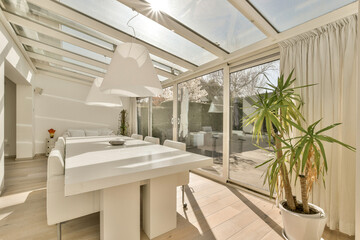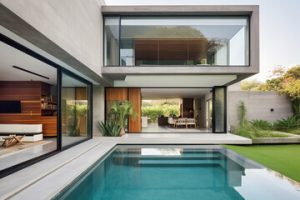Modern house designs have become a leading trend in residential architecture, offering sleek aesthetics, open spaces, and functional layouts that reflect today’s lifestyle needs. These designs prioritize simplicity, natural light, and smart use of space while incorporating sustainable materials and innovative technology. Whether you are planning to build a new home or renovate an existing one, understanding the essential elements of modern architecture will help you create a stylish, efficient, and future-ready home.

1. Clean Lines and Minimalist Aesthetics
One of the hallmarks of modern house designs is simplicity. Straight lines, flat or low-pitched roofs, and geometric shapes are commonly used to create a clean and uncluttered look. Instead of ornate details, modern homes focus on functionality and form. Neutral color palettes like white, gray, beige, and black often dominate the exterior and interior, complemented by natural accents such as wood or stone.
2. Open Floor Plans for Fluid Spaces
Modern homes emphasize openness and connectivity. Open floor plans eliminate unnecessary walls, allowing living rooms, kitchens, and dining areas to blend seamlessly. This design enhances natural light flow, creates a sense of spaciousness, and promotes social interaction. Sliding glass doors and large windows further blur the line between indoor and outdoor living, making spaces feel airy and connected to nature.
3. Large Windows and Natural Light
Natural light plays a major role in modern architecture. Expansive windows, glass walls, and skylights bring in abundant daylight, reducing the need for artificial lighting and improving energy efficiency. Floor-to-ceiling windows are a common feature, offering stunning views and enhancing the feeling of openness. Using energy-efficient glass helps maintain comfort while minimizing heat transfer.
4. Sustainable and Eco-Friendly Materials
Sustainability is at the heart of modern design. Many homeowners are choosing eco-friendly materials such as reclaimed wood, bamboo flooring, recycled steel, and low-VOC paints. Energy-efficient appliances, water-saving fixtures, and solar panels further reduce environmental impact while lowering utility costs. Incorporating green roofs or living walls can also enhance insulation and air quality.
5. Functional Kitchen Designs
The kitchen in a modern home is not just for cooking—it’s a central hub for socializing and entertaining. Modern kitchen designs often feature sleek cabinetry, integrated appliances, and ample counter space. Islands with built-in storage and seating add both functionality and style. Minimalist hardware, matte finishes, and under-cabinet lighting contribute to a clean, contemporary look.
6. Smart Home Technology Integration
Technology plays an important role in modern homes. Smart systems for lighting, heating, security, and entertainment allow homeowners to control their living environment with ease. Automated blinds, voice-activated assistants, and energy-monitoring devices enhance comfort and efficiency while providing a futuristic living experience.

7. Indoor-Outdoor Connection
Modern house designs often extend living spaces outdoors through patios, decks, and balconies. Outdoor kitchens, lounge areas, and fire pits create inviting spaces for relaxation and entertainment. Using similar materials and design elements for both indoor and outdoor areas ensures a seamless transition between the two.
8. Unique Architectural Features
To break away from uniformity, many modern homes incorporate striking design elements such as cantilevered sections, floating staircases, or double-height ceilings. Exposed beams, polished concrete floors, and metal accents add character while maintaining the minimalist aesthetic. Creative use of lighting, including recessed fixtures and LED strips, can highlight these features and create visual interest.
9. Neutral Colors with Bold Accents
While modern homes typically feature neutral base colors, adding bold accents through furniture, artwork, or statement walls can create a striking effect. Colors like navy, deep green, or burnt orange work well as accent tones, especially when paired with natural textures like wood and stone.
10. Flexible Spaces for Modern Living
As lifestyles evolve, so do design needs. Modern homes often include flexible spaces that can serve multiple purposes. A home office that doubles as a guest room or a finished basement that functions as both a play area and a media room ensures adaptability for different stages of life.